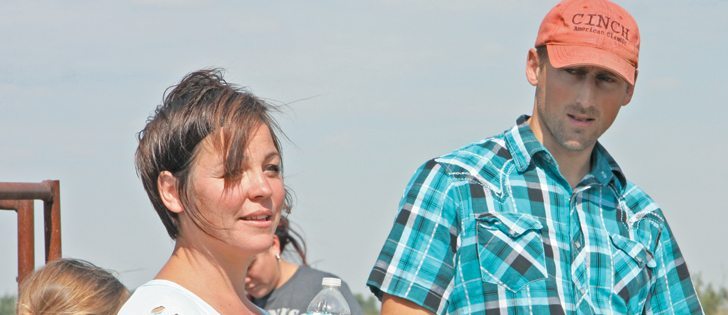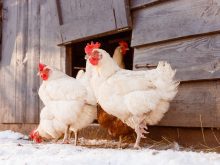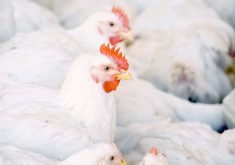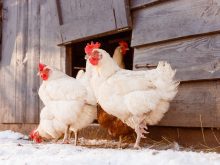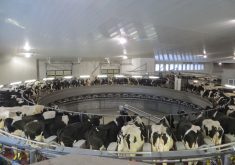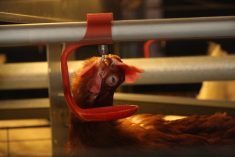Old-fashioned farming | Couple refocuses efforts on grass-fed pigs and cattle
VIKING, Alta. — The tour could have been called Confessions of a Farmer.
Instead of painting a bucolic picture of contented animals happily grazing and frolicking in the fields, Shannon and Danny Ruzicka told about dead stock, poor choices and the pitfalls of raising livestock the old-fashioned way.
Visitors may like to see chickens clucking and scratching around the farmyard, but they are difficult to raise in large numbers.
Heat, wind storms, pecking chickens, expensive processing costs, hawks and unsuitable breeds of pasture chickens have convinced the Ruzicka family to abandon poultry on pasture and concentrate instead on pigs and cows.
Read Also

Farming Smarter receives financial boost from Alberta government for potato research
Farming Smarter near Lethbridge got a boost to its research equipment, thanks to the Alberta government’s increase in funding for research associations.
This year, the family tried raising the Barred Rock heritage breed. The black, white and grey-feathered chickens look regal in pictures but not on the plate. Instead of taking six weeks to reach slaughter weight, as do modern breeds, after four months the Barred Rock broilers appear ready for the stew pot instead of the roasting oven.
“After 16 weeks they’re skin and bone. They’re long, no breast and have skinny legs,” Shannon told a group of small scale livestock producers during a tour of the Ruzickas’ Nature’s Green Acres farm, organized by Alberta Agriculture.
“They are what chickens are. They grow slowly,” said Shannon, who wanted to raise the heritage breed to help promote and save it.
Francine Gomes of Castelgar, B.C., said she tried and abandoned the Barred Rock, opting instead for the Mistral Gris breed. The four-way cross chicken, which was developed in the United States and is now available in Langley, B.C., is considered a good alternative for pasture raised poultry.
“They’re an amazing bird. They’re big, meaty, with huge thighs and legs,” Gomes said during a discussion on the pitfalls of pasture poultry and choosing the best breed.
Like most great ideas, troubles multiply with the number of animals.
Raising 200 chickens on pasture was manageable for the Ruzickas in the first year but not in the second year, when they raised 1,000 chickens on pasture. More than 600 broilers either pecked each other to death, died because of the humidity in the brooder or were squashed when the shelter was moved.
“It was a huge learning lesson,” said Shannon.
“We didn’t want anyone to see them.”
The Ruzickas’ chicken-raising confessions were balm for Debbie Schielke of New Norway, Alta., who has also quit raising broiler chickens because of the difficulty.
“I haven’t had broilers for two years. It was a walk of shame. I was thinking I was the only one doing this wrong,” said Schielke.
“They’re labour intensive and there’s not a lot of money to be made.… Chicken is a young woman’s game.”
For the Ruzickas, pork and beef have become their specialty.
The Tamworth and Large Black pig crosses are raised in an eight-acre bush pasture and finished with a mixture of wheat, peas and barley.
The pigs are sold as wholes or halves to encourage customers to eat from “nose to tail.”
Pens of Landrace pigs are raised on pasture and moved twice a day to allow them to forage in fresh grass.
The pigs have become a favourite with Edmonton chefs, who feature the family’s pork and beef on restaurant menus.
Unlike other farms, which finish calves on pasture or grain, Nature’s Green Acres butchers its calves at seven months and sells them as halves or wholes. The Ruzickas say the young animals, which they call Nouveau Beef, are ideal for customers who want tender beef in small portions.
Shannon describes the young meat as a cross between beef and veal. Originally starting with five animals, this year the family will sell 60 Nouveau Beef animals.
Making connections with Alberta chefs has also been a marketing marriage that works. Customers have connected with the family by eating at the restaurants that promote their meat or through the downtown Edmonton Farmers’ Market, which the couple attends during the summer.
As well, the Edmonton restaurant Rge Rd has teamed up with the Ruzickas to create a meal in the field using food foraged from the pasture or raised in the farm’s garden.
The 150 customers dine on a long table in the field beside tipi rings and a slow moving creek.
“It’s fine dining in the middle of a cow pasture,” Shannon said.
Danny said the publicity and attendance has helped boost sales of their farm produce.
“It’s turned into a huge marketing tool.”
The connections the Ruzickas have made with customers, chefs and other food lovers allow them to make a living on their 320-acre farm.
“It’s what we enjoy and it’s profitable,” said Shannon.



